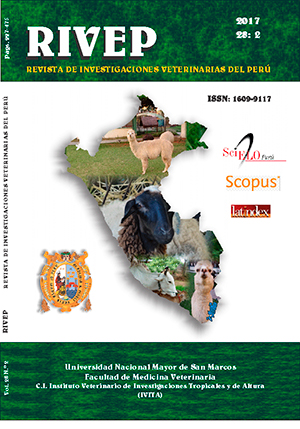Genetic markers of colour for determining the genetic structure of domestic cats (Felis catus) in rural areas of Lorica, Colombia
DOI:
https://doi.org/10.15381/rivep.v28i2.13056Keywords:
genetic diversity, allele frequencies, heterozygosity, Hardy-Weinberg equilibrium, habitatAbstract
The aim of this study was to analyse the genetic structure of domestic cats (Felis catus) in rural environments in Lorica, Colombia using morphological markers of colour. A phenotypic classification was made of 134 individuals distributed in three populations, attending to the presence or absence of the autosomal markers Non-agouti, Blotched tabby, Dilution, White spotting, Dominant white and the marker Orange linked to sex. The Blotched tabby marker was the most frequent and showed a possible natural selection, while Dominant white showed the lowest values. Populations showed absence of Hardy-Weinberg equilibrium. Moreover, an excess of homozygotes was evident, and differences between populations and scarce gene flow between populations was found. Polymorphism of genes that encode the colour of cats in rural habitats likely differ from domestic conditions in urban environment.Downloads
Downloads
Published
Issue
Section
License
Copyright (c) 2017 Luis Alfonso Causil Vargas, Adrián Rodríguez De La Barrera, Orlando Causil Vargas

This work is licensed under a Creative Commons Attribution-NonCommercial-ShareAlike 4.0 International License.
AUTHORS RETAIN THEIR RIGHTS:
a. Authors retain their trade mark rights and patent, and also on any process or procedure described in the article.
b. Authors retain their right to share, copy, distribute, perform and publicly communicate their article (eg, to place their article in an institutional repository or publish it in a book), with an acknowledgment of its initial publication in the Revista de Investigaciones Veterinarias del Perú (RIVEP).
c. Authors retain theirs right to make a subsequent publication of their work, to use the article or any part thereof (eg a compilation of his papers, lecture notes, thesis, or a book), always indicating the source of publication (the originator of the work, journal, volume, number and date).










